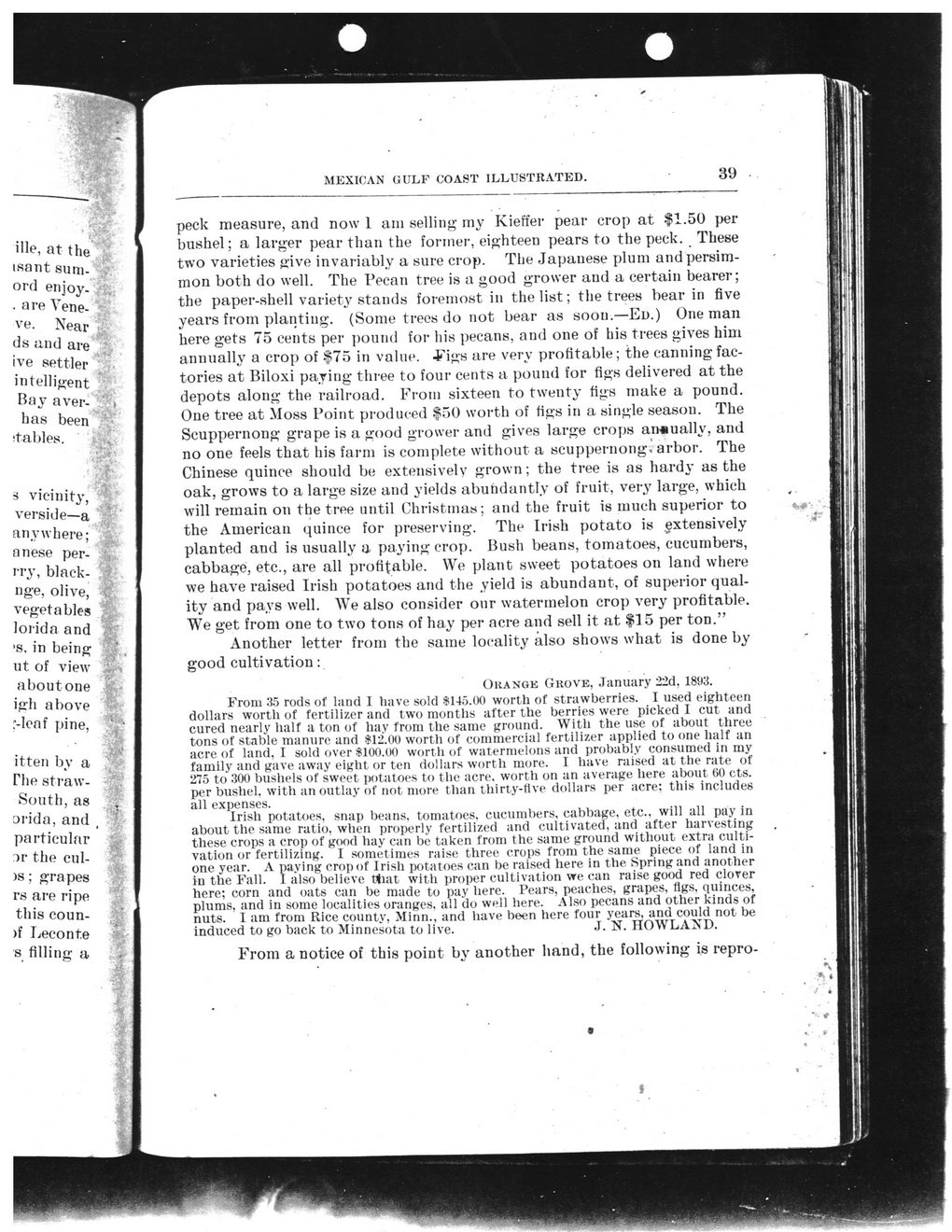This text was obtained via automated optical character recognition.
It has not been edited and may therefore contain several errors.
MEXICAN GULF COAST ILLUSTRATED. 39 j|le, at the% isant sum- ^ ord enjoy-M • areVene. J- ve- Near lids and are" |£ ive settler intelligent tj*'- Ray aver-has been % stables. w S vicinity, verside—a anywhere; VJ£; anese per-i r.V, black- % nge, olive, % vegetables lorida and ‘s. in being ut of view about one igh above :-leaf pine, it ten by a The straw-South, as ai'ida, and , particular )r the cul-)s; grapes rs are ripe this coun->f Leconte s filling a peck measure, and now 1 am selling my Kieffer pear crop at $1.50 per bushel; a larger pear than the former, eighteen pears to the peck. These two varieties give invariably a sure crop. The Japanese plum and persimmon both do well. The Pecan tree is a good grower aud a certain bearer; the paper-shell variety stands foremost in the list; the trees bear in five years from planting. (Some trees do not bear as soon.—Ed.) One man here gets 75 cents per pound for his pecans, and one of his trees gives him annually a crop of $75 in value. -Figs are very profitable; the canning factories at Biloxi paying three to four cents a pound for figs delivered at the depots along the railroad. From sixteen to twenty figs make a pound. One tree at Moss Point produced $50 worth of figs in a single season. The Scuppernong grape is a good grower and gives large crops an*uallv, and no one feels that his farm is complete without a scuppernong. arbor. The Chinese quince should be extensively grown; the tree is as hardy as the oak, grows to a large size and yields abundantly of fruit, very large, which will remain on the tree until Christmas; and the fruit is much superior to the American quince for preserving. The Irish potato is gxtensively planted and is usually a paying crop. Bush beans, tomatoes, cucumbers, cabbage, etc., are all profitable. We plant sweet potatoes on land where we have raised Irish potatoes and the yield is abundant, of superior quality and pays well. We also consider our watermelon crop very profitable. We get from one to two tons of hay per acre and sell it at $15 per ton.” Another letter from the same locality also shows what is done by good cultivation: Oka nge Grove, January 22d, 1893. From 35 rods of land I have sold $145.00 worth of strawberries. I used eighteen dollars worth of fertilizer and two months after the berries were picked I cut and cured nearly half a ton of hay from the same ground. With the use of about three tons of stable manure and $12.00 worth of commercial fertilizer applied to one half an acre of land, I sold over $100.00 worth of watermelons and probably consumed in my family and gave away eight or ten dollars worth more. I have raised at the rate of 275 to 300 bushels of sweet potatoes to the acre, worth on an average here about 60 cts. per bushel, with an outlay of not more than thirty-five dollars per acre; this includes all expenses. Irish potatoes, snap beans, tomatoes, cucumbers, cabbage, etc., will all pay in about the same ratio, when properly fertilized and cultivated, and after harvesting these crops a crop of good hay can be taken from the same ground without extra cultivation or fertilizing. I sometimes raise three crops from the same piece of land in one year. A paying crop of Irish potatoes can be raised here in the Spring and another In the Fall. I also believe fifiat with proper cultivation we can raise good red clover here; corn and oats can be made to pay here. Pears, peaches, grapes, figs. quinces, plums, and in some localities oranges, all do well here. Also pecans and other kinds of nuts. 1 am from Rice county, Minn., and have been here four years, and could not be induced to go back to Minnesota to live. J. N. HOWLAND. From a notice of this point by another hand, the following is repro- ■P \ f

Mexican Gulf Coast The Mexican Gulf Coast on Mobile Bay and Mississippi Sound - Illustrated (38)